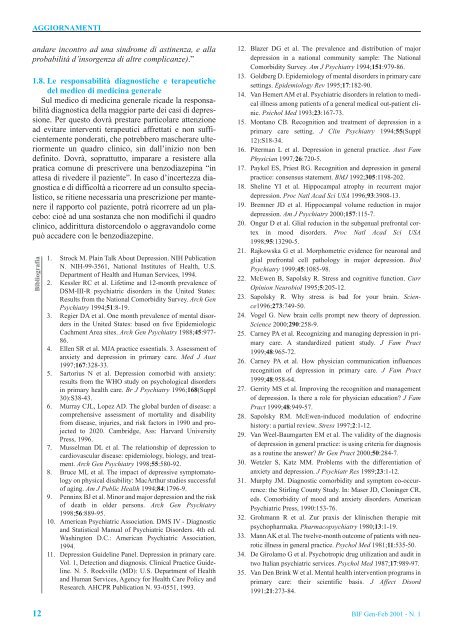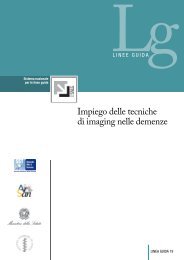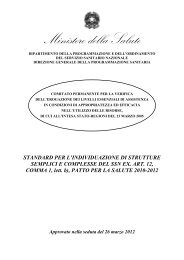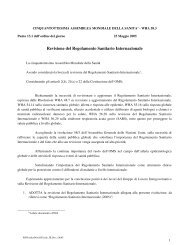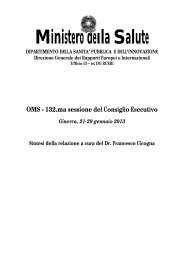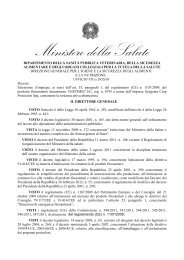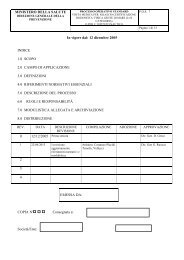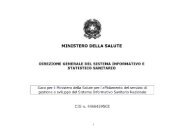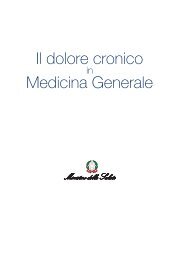I farmaci del servizio sanitario nazionale - Ministero della Salute
I farmaci del servizio sanitario nazionale - Ministero della Salute
I farmaci del servizio sanitario nazionale - Ministero della Salute
Create successful ePaper yourself
Turn your PDF publications into a flip-book with our unique Google optimized e-Paper software.
AGGIORNAMENTI<br />
andare incontro ad una sindrome di astinenza, e alla<br />
probabilità d’insorgenza di altre complicanze).”<br />
1.8. Le responsabilità diagnostiche e terapeutiche<br />
<strong>del</strong> medico di medicina generale<br />
Sul medico di medicina generale ricade la responsabilità<br />
diagnostica <strong>del</strong>la maggior parte dei casi di depressione.<br />
Per questo dovrà prestare particolare attenzione<br />
ad evitare interventi terapeutici affrettati e non sufficientemente<br />
ponderati, che potrebbero mascherare ulteriormente<br />
un quadro clinico, sin dall’inizio non ben<br />
definito. Dovrà, soprattutto, imparare a resistere alla<br />
pratica comune di prescrivere una benzodiazepina “in<br />
attesa di rivedere il paziente”. In caso d’incertezza diagnostica<br />
e di difficoltà a ricorrere ad un consulto specialistico,<br />
se ritiene necessaria una prescrizione per mantenere<br />
il rapporto col paziente, potrà ricorrere ad un placebo:<br />
cioè ad una sostanza che non modifichi il quadro<br />
clinico, addirittura distorcendolo o aggravandolo come<br />
può accadere con le benzodiazepine.<br />
Bibliografia<br />
1. Strock M. Plain Talk About Depression. NIH Publication<br />
N. NIH-99-3561, National Institutes of Health, U.S.<br />
Department of Health and Human Services, 1994.<br />
2. Kessler RC et al. Lifetime and 12-month prevalence of<br />
DSM-III-R psychiatric disorders in the United States:<br />
Results from the National Comorbidity Survey. Arch Gen<br />
Psychiatry 1994;51:8-19.<br />
3. Regier DA et al. One month prevalence of mental disorders<br />
in the United States: based on five Epidemiologic<br />
Cachment Area sites. Arch Gen Psychiatry 1988;45:977-<br />
86.<br />
4. Ellen SR et al. MJA practice essentials. 3. Assessment of<br />
anxiety and depression in primary care. Med J Aust<br />
1997;167:328-33.<br />
5. Sartorius N et al. Depression comorbid with anxiety:<br />
results from the WHO study on psychological disorders<br />
in primary health care. Br J Psychiatry 1996;168(Suppl<br />
30):S38-43.<br />
6. Murray CJL, Lopez AD. The global burden of disease: a<br />
comprehensive assessment of mortality and disability<br />
from disease, injuries, and risk factors in 1990 and projected<br />
to 2020. Cambridge, Ass: Harvard University<br />
Press, 1996.<br />
7. Musselman DL et al. The relationship of depression to<br />
cardiovascular disease: epidemiology, biology, and treatment.<br />
Arch Gen Psychiatry 1998;55:580-92.<br />
8. Bruce ML et al. The impact of depressive symptomatology<br />
on physical disability: MacArthur studies successful<br />
of aging. Am J Public Health 1994;84:1796-9.<br />
9. Penninx BJ et al. Minor and major depression and the risk<br />
of death in older persons. Arch Gen Psychiatry<br />
1998;56:889-95.<br />
10. American Psychiatric Association. DMS IV - Diagnostic<br />
and Statistical Manual of Psychiatric Disorders. 4th ed.<br />
Washington D.C.: American Psychiatric Association,<br />
1994.<br />
11. Depression Gui<strong>del</strong>ine Panel. Depression in primary care.<br />
Vol. 1, Detection and diagnosis. Clinical Practice Gui<strong>del</strong>ine.<br />
N. 5. Rockville (MD): U.S. Department of Health<br />
and Human Services, Agency for Health Care Policy and<br />
Research. AHCPR Publication N. 93-0551, 1993.<br />
12. Blazer DG et al. The prevalence and distribution of major<br />
depression in a national community sample: The National<br />
Comorbidity Survey. Am J Psychiatry 1994;151:979-86.<br />
13. Goldberg D. Epidemiology of mental disorders in primary care<br />
settings. Epidemiology Rev 1995;17:182-90.<br />
14. Van Hemert AM et al. Psychiatric disorders in relation to medical<br />
illness among patients of a general medical out-patient clinic.<br />
Psichol Med 1993;23:167-73.<br />
15. Montano CB. Recognition and treatment of depression in a<br />
primary care setting. J Clin Psychiatry 1994;55(Suppl<br />
12):S18-34.<br />
16. Piterman L et al. Depression in general practice. Aust Fam<br />
Physician 1997;26:720-5.<br />
17. Paykel ES, Priest RG. Recognition and depression in general<br />
practice: consensus statement. BMJ 1992;305:1198-202.<br />
18. Sheline YI et al. Hippocampal atrophy in recurrent major<br />
depression. Proc Natl Acad Sci USA 1996;93:3908-13.<br />
19. Bremner JD et al. Hippocampal volume reduction in major<br />
depression. Am J Psychiatry 2000;157:115-7.<br />
20. Ongur D et al. Glial reducion in the subgenual prefrontal cortex<br />
in mood disorders. Proc Natl Acad Sci USA<br />
1998;95:13290-5.<br />
21. Rajkowska G et al. Morphometric evidence for neuronal and<br />
glial prefrontal cell pathology in major depression. Biol<br />
Psychiatry 1999;45:1085-98.<br />
22. McEwen B, Sapolsky R. Stress and cognitive function. Curr<br />
Opinion Neurobiol 1995;5:205-12.<br />
23. Sapolsky R. Why stress is bad for your brain. Science1996;273:749-50.<br />
24. Vogel G. New brain cells prompt new theory of depression.<br />
Science 2000;290:258-9.<br />
25. Carney PA et al. Recognizing and managing depression in primary<br />
care. A standardized patient study. J Fam Pract<br />
1999;48:965-72.<br />
26. Carney PA et al. How physician communication influences<br />
recognition of depression in primary care. J Fam Pract<br />
1999;48:958-64.<br />
27. Gerrity MS et al. Improving the recognition and management<br />
of depression. Is there a role for physician education? J Fam<br />
Pract 1999;48:949-57.<br />
28. Sapolsky RM. McEwen-induced modulation of endocrine<br />
history: a partial review. Stress 1997;2:1-12.<br />
29. Van Weel-Baumgarten EM et al. The validity of the diagnosis<br />
of depression in general practice: is using criteria for diagnosis<br />
as a routine the answer? Br Gen Pract 2000;50:284-7.<br />
30. Wetzler S, Katz MM. Problems with the differentiation of<br />
anxiety and depression. J Psychiatr Res 1989;23:1-12.<br />
31. Murphy JM. Diagnostic comorbidity and symptom co-occurrence:<br />
the Stirling County Study. In: Maser JD, Cloninger CR,<br />
eds. Comorbidity of mood and anxiety disorders. American<br />
Psychiatric Press, 1990:153-76.<br />
32. Grohmann R et al. Zur praxis der klinischen therapie mit<br />
psychopharmaka. Pharmacopsychiatry 1980;13:1-19.<br />
33. Mann AK et al. The twelve-month outcome of patients with neurotic<br />
illness in general practice. Psychol Med 1981;11:535-50.<br />
34. De Girolamo G et al. Psychotropic drug utilization and audit in<br />
two Italian psychiatric services. Psychol Med 1987;17:989-97.<br />
35. Van Den Brink W et al. Mental health intervention programs in<br />
primary care: their scientific basis. J Affect Disord<br />
1991;21:273-84.<br />
12 BIF Gen-Feb 2001 - N. 1


